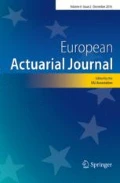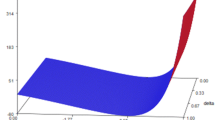Abstract
The article deals with the fundamental features of a solvency regime: valuation and risk modelling. The paper argues that for solvency testing purposes the valuation method of choice is market consistent valuation. Statutory valuation based on historical costs is at best irrelevant and possibly misleading in the case of a compulsory winding up of a company and of forced sales of assets. As far as risk modelling is concerned, it is argued that stress tests and scenarios have an important role to play. They can complement or replace stochastic risk models. They have in particular the advantage of enabling an effective involvement of senior managers and Board members in the company’s quantitative risk management. It is argued that supervisors could use two co-existing models for solvency testing purposes: a probabilistic model and a set of scenarios based Solvency Capital Requirements. The paper draws on the experience of the EU regulatory authorities, CEIOPS and EIOPA, with the development of Solvency II. It also draws on the experience of FINMA, the Swiss supervisory authority, with the implementation of the Swiss Solvency Test. Finally, it takes into account the lessons of the Japanese life insurance crisis from 1997 to 2001.


Similar content being viewed by others
References
FINMA Insurance Market Report 2014, 10/33. https://www.finma.ch/en/documentation/finma-publications/reports/insurance-reports/
Freeman M, Fujiki M (2001) Why some Japanese Insurers are Failing, Emphasis 2001/3
Uemura N (2008) The failure without management. Oriental Life Insurance Cultural Development Center, Tokyo
Solvency II Directive 2014/51 of the European Parliament and of the Council including “Omnibus II” and the Long-Term Guarantee Measures
Domanski D, Shin HS, Suhko V (2015) The hunt for duration: not waving but drowning? BIS Working Paper No 519
FINMA-Rundschreiben 2013/2 SST Erleichterungen. https://www.finma.ch/en/documentation/circulars
Swiss National Bank (2014) Implementing the Countercyclical Capital Buffer in Switzerland, February 2014
McNeil AJ, Frey R, Embrechts P (2015) Quantitative risk management, Revised edition
Weber AA (2009) Pfandbriefmarkt und Finanzmarktkrise, Rede beim Jahresempfang des Verbandes Deutscher Pfandbriefbanken in Berlin am 26. November 2009
Rebonato R (2010) Coherent stress testing, a Bayesian approach to the analysis of financial stress. Wiley, Oxford
FINMA, Wegleitung für die Erarbeitung des SST-Berichtes 2016. https://www.finma.ch/en/supervision/insurers/cross-sectoral-tools/swiss-solvency-test-sst/
FINMA, SST 2015 Survey. https://www.finma.ch/en/supervision/insurers/cross-sectoral-tools/swiss-solvency-test-sst/
Cont R, Schaanning E (2016) Fire sales, indirect contagion and systemic stress-testing. Norges Bank Working Paper 2/2017
Author information
Authors and Affiliations
Corresponding author
Glossary
- EIOPA
-
European Insurance and Occupational Pension Authority
- CEIOPS
-
Predecessor Organisation of EIOPA
- FINMA
-
Finanzmarktaufsicht, Swiss financial market supervisor
- SST
-
Swiss Solvency Test
Rights and permissions
About this article
Cite this article
Schnieper, R. Defining principles of a robust insurance solvency regime. Eur. Actuar. J. 8, 169–196 (2018). https://doi.org/10.1007/s13385-018-0169-3
Received:
Revised:
Accepted:
Published:
Issue Date:
DOI: https://doi.org/10.1007/s13385-018-0169-3




